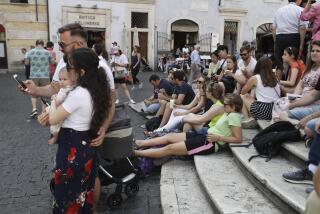Old Europe without Europe’s new prices
- Share via
IF your heart is set on Europe but you hesitate because of the high prices and weak dollar, consider a peek at the low-profile country of Slovenia.
Slovenia, formerly an iron curtain country, is at the northernmost section of the former Yugoslavia. It is smaller than New Jersey but is filled with Baroque cities and Alpine lakes, fine wines and Adriatic resorts, all virtually unaffected by Yugoslavia’s civil war in the 1990s. Yet Slovenia is so little known to American tourists that most confuse it with Slovakia.
This relative anonymity is a boon, because Slovenia -- tucked under the Julian Alps just south of Austria and east of Italy -- receives only a fraction of the crowds that drive up the hotel prices and travel costs in its Western European neighbors. Hotel rooms that cost about $80 in the capital, Ljubljana, would easily cost twice that just across the borders in the cities of Vienna or Venice, and a restaurant meal with multiple courses and a bottle of fine Slovenian Riesling rarely rings in at more than $25 per person.
Ljubljana is 3 1/4 hours by train from Trieste, Italy, www.raileurope.com, a three-hour flight from London (starting at about $90) or 1 1/2 hours from Berlin (at about $25) aboard the no-frills airline EasyJet, www.easyjet.com.
The most scenic way to ease into Slovenia is to catch a train from the bisected border town of Gorizia, Italy, and Nova Gorica, Slovenia. For years the town was divided down the middle by the iron curtain. The 99-year-old Transalpina rail line travels from Nova Gorica up the beautiful Soca River valley.
The river’s beauty -- waters tinged emerald by calcium carbonate from the surrounding limestone mountains -- belies its bloody role in World War I, when as many as 1 million lives (by some estimates) were lost near the river between 1915 and 1917. If that sounds familiar to Hemingway fans, it’s because he set “A Farewell to Arms” here, though he used the Italian name for the river and called it the Isonzo Front.
Hop off the train in Bled Jezero and leave behind mementos of past wars in favor of the fairy-tale scenery of Lake Bled, Slovenia’s premier Alpine resort. The little blue lake is surrounded by the craggy Julian Alp peaks of Triglav National Park -- popular for rafting and mountain biking.
There’s a modest resort town at one end of the lake, where accommodations include the Penzion Bledec youth hostel, with $22 to $25 beds, www.mlino.si, and the Penzion Mayer, a family-run hotel with spotless $60 rooms and an excellent restaurant, www.mayer-sp.si. But Bled’s real claims to fame are the lake’s tiny wooded island spiked with a Baroque church steeple and the 1,000-year-old castle sitting atop a cliff.
It’s a quick train ride from Bled to Ljubljana, a city blessed with streets lined by Baroque and Art Nouveau buildings and a bustling daily market in the square between the cathedral and the cafe-lined promenades of the Ljubljanica River. A castle watches over it from a bluff high above the narrow medieval alleys of the ancient city core. Ljubljana is often touted as an alternative to Prague, and although it does enjoy a similar look and style, that’s stretching things a bit. This tiny capital lacks Prague’s great museums and superlative sights, but it also lacks Prague’s crowds and prices.
One of the most popular places to stay is the Hostel Celica, a former prison that’s a five-minute walk from the train station. Each cell has been transformed into a unique designer room sleeping two or three people for $23 to $28 each; standard dorms sleeping 14 start at $19, www.hostelcelica.com.
From the city, take a day trip to the Adriatic coast and the tiny, ancient port town of Piran on the Istrian Peninsula. The flavor of this overgrown fishing village is decidedly Italian.
Pop into a cafe near Piran’s main Prvomajski Square, order a glass of wine or Slovenian beer, breathe the sea air and get a taste of old Europe.
More to Read
Sign up for The Wild
We’ll help you find the best places to hike, bike and run, as well as the perfect silent spots for meditation and yoga.
You may occasionally receive promotional content from the Los Angeles Times.





